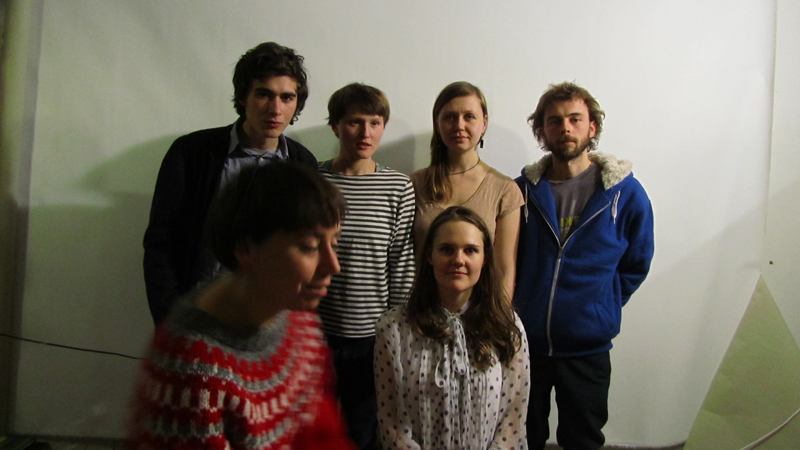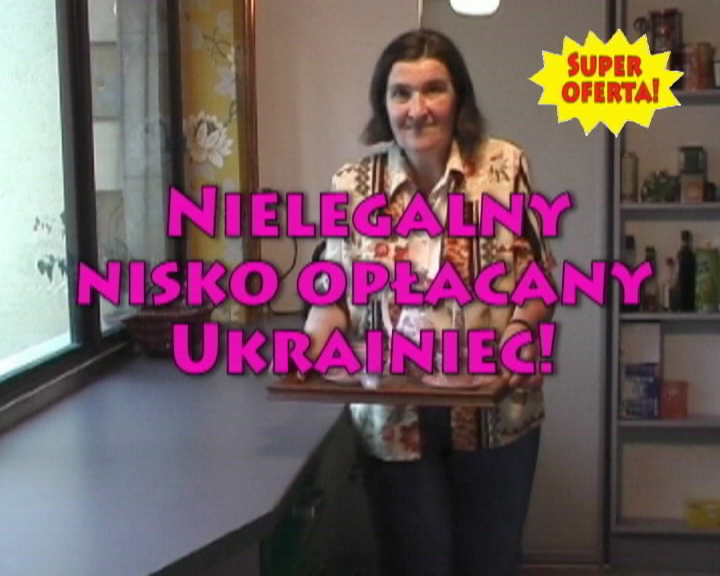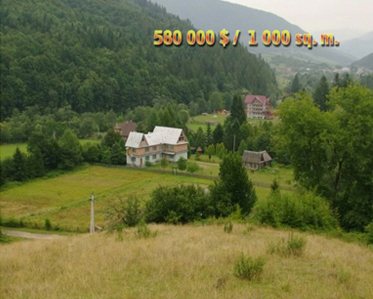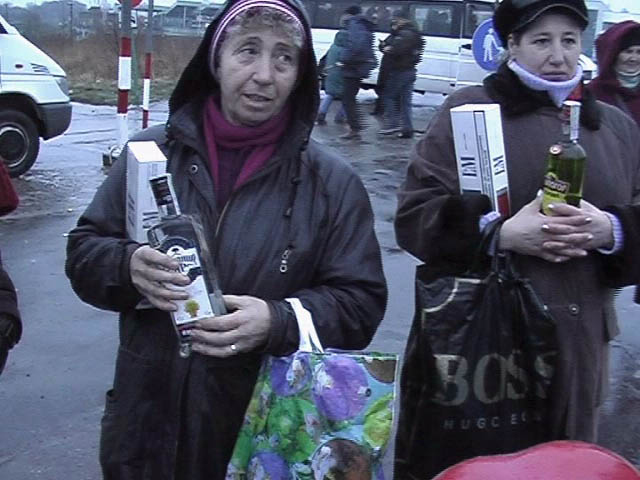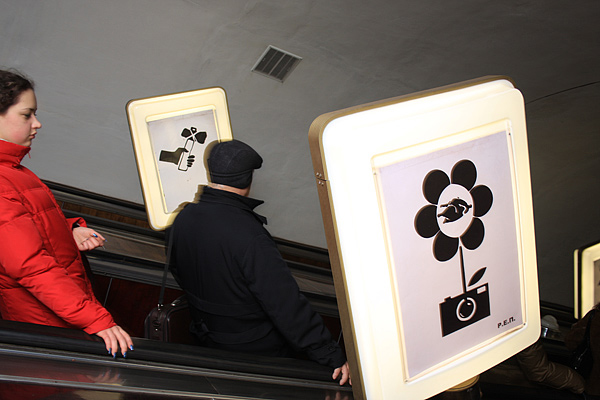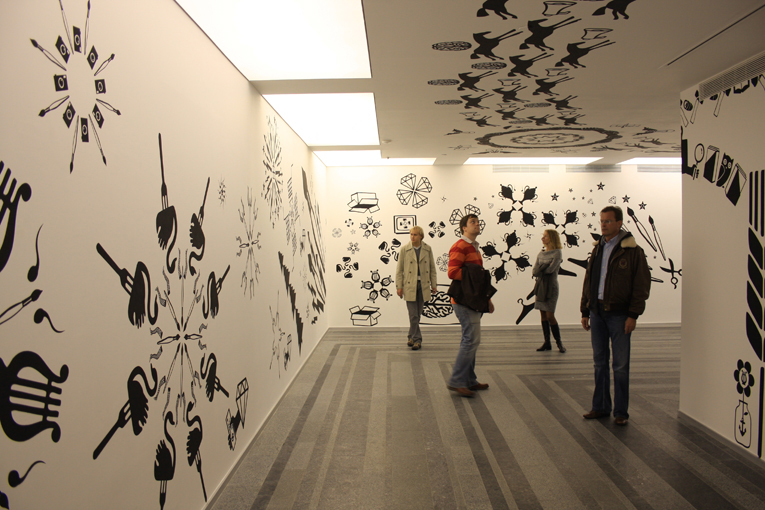R.E.P. Group in Conversation with Larissa Babij (Interview)
The R.E.P. (Revolutionary Experimental Space) Group, which debuted in 2004 with art-protest actions during the Orange Revolution, is now one of Ukraine’s best-known young contemporary artist collectives. Its members each maintain their own artistic practice in addition to producing projects together. Also acting as curators, they continue to play a significant role in highlighting the activities of other Ukrainian artists of their generation, especially those involved in social-political activism. In recent years, R.E.P. has been attracting more attention abroad, taking part in exhibitions in Hungary, Russia, Sweden, Estonia, Italy and other European countries. http://www.rep.tinka.cc/
Larissa Babij: Tell me about your recent projects, especially Euro-Renovation in Europe, which you presented in Munich recently.
Nikita Kadan: At the Supermarket artist-run fair in Stockholm we presented a project called Motherland Shop (2010). The whole supermarket is an art fair of artist-run galleries, not-for-profit spaces, art groups, even village communes. We had a booth painted in light blue and a sign on the wall – Motherland Shop – in gold and blue. And there we presented three of our video works. One of them, from 2008, is called Superproposition and it’s an advertisement for illegal Ukrainian workers that is addressed to their potential Western employers. The second one is a new video work called Ukrainian Land (2010). It is a rather romantic one-minute film that shows Ukrainian landscapes filmed by television camera operators, but we added the price of the land because there is now discussion about lifting the moratorium on selling land in Ukraine. The third video is about Ukrainian official art institutions which are totally closed to international processes and which maintain this position of culture being something that is only for internal (i.e., Ukrainian) use.
The second project, Euro-Renovation in Europe (2010), was realized at the Kunstraum in Munich, and there we described the phenomenon of Euro-renovation. Its architectural style and interior design, its clothes, TV programs, art, furniture, and public politics. The style of what we call Euro-renovation is the domain of post-Soviet space, as in: those who failed in the Cold War trying to imitate the way of life and style of the winners, the style of the West. But they didn’t know very much about real Western life, so they created some strange copy, which to Western people seems like a bit of a caricature. But at the same time, presenting this style in the West is a critical gesture directed at the position of Western domination, whereby the West is perceived as “normal” and the East as “socially pathological.”
 Olesia Khomenko: Actually this really is a big phenomenon in present-day Ukraine, but we think that it’s not studied enough. We try to investigate it in our “art dimension.” We made a film and we interviewed a professional decorator who deals with such Euro-renovation all the time. She provided some historical background for us and for our public. Then we asked her to produce special sketches for the space in Munich. She designed a corner. We didn’t renovate an old space; instead we made an installation, like a glass display case. It really was a corner: two walls without furniture, only the most basic form of renovation.
Olesia Khomenko: Actually this really is a big phenomenon in present-day Ukraine, but we think that it’s not studied enough. We try to investigate it in our “art dimension.” We made a film and we interviewed a professional decorator who deals with such Euro-renovation all the time. She provided some historical background for us and for our public. Then we asked her to produce special sketches for the space in Munich. She designed a corner. We didn’t renovate an old space; instead we made an installation, like a glass display case. It really was a corner: two walls without furniture, only the most basic form of renovation.
The first idea was to present it anywhere in Western Europe, in some old building. To make this old building, let’s say, “better” and “modern” in the way that it’s understood here [in Ukraine]. To bring this mentality to Western Europe and to create something like a reflection on questions such as: What is beauty? What is “paradise”? What is modern life? What is “Europe”?
Lada Nakonechna: This project is not only about architecture, but we show it through architecture, through interior design. We also plan to make a publication in which we show this phenomenon of Euro-renovation in a wider perspective. We will take interviews and include texts from the architectural and the social sphere.
LB: So you’re making a wider commentary about Ukrainian culture and about how people think through their architecture…
NK: Renovation is a style of life. It’s really about the plaster used for decorations and temporary constructions. And people try to build a whole society from this temporary construction material. And it seems that everybody who acts in this way thinks that all this parliamentary democracy and being part of the globalized, neo-liberal world is really temporary, that it’s not forever and that very soon we have to pack our things and run away somewhere.
OK: It’s as if they are afraid of building something stronger. Or maybe it’s a question of not understanding what’s going on, or more generally, what direction society is moving in, and where we need to build.
LB: How was this project received in Germany? Was it perceived more like a project about Ukraine or more generally like a worldview, a way of looking at society?
OK: In my opinion, it’s more about the relation between Ukraine and the globalized world. We’ve heard a lot of criticism that we [R.E.P.] just present some caricature of Ukraine abroad. But in my view that’s a very simplistic reflection because we represent our experience. As we become involved in larger (art) processes in Ukraine, we observe a lot of limitations connected with language, with education, with everything, with one’s background generally. All the time we try to transgress this border. And we invent different, perhaps utopian strategies, such as a universal language in Patriotism (2006-2010). Euro-Renovation uses architecture as a metaphor. We don’t want to be very direct; instead we want to address a type of thinking.
LB: I’m not convinced that Euro-Renovation in Europe represents your own personal experience. It seems that in this project you are working more like ethnographers researching your own country and then displaying your observations elsewhere.
NK: I think it’s mistaken to consider this project, and also the Motherland Shop, as ethnographic. I mean, it’s not a case of self-orientalization, it does not present the East as an object for contemplation from the position of Western norms. Rather we put the accent on the subjectivities of post-Soviet space, we argue that it is not merely some caricatured and grotesque object for observation and that it has its own perspective on the West. And we want to show the West (in the West) the East’s view of the West. So we put up not one mirror, but two. And they reflect one another. One is located in post-Soviet space, the other in the so-called free, united Europe. And we create a situation of innumerable reciprocal reflections that with every change of context reveal new images.
LB: Over the past five years the R.E.P. group has emerged as one of a few Ukrainian art collectives that regularly show work abroad, something like a “business card” for young Ukrainian contemporary art. How does this status affect your artistic practice?
NK: We regard this as a normal working situation. On the other hand, in Ukraine people usually react strongly-either very positively or very negatively-to this situation. For us, it’s become our working rhythm.
OK: I’d like to describe how this influences our work. The project Smuggling (2007) where we cross the Polish-Ukrainian border-the border with the European Union-on foot, illegally carrying petroleum and natural gas, developed as a direct result of this [international] experience. We would travel to Poland relatively often and we didn’t always have a big enough exhibition budget (there are six of us), so we would travel in segments and cross the border on foot, which was the cheapest way. And we noticed this general transit phenomenon, which sparked the idea to also take part in this. We examined the phenomenon of transit in a wider sense for ourselves,since we are a country in transition in both a temporal and a geopolitical sense. We illegally transported goods of literal geopolitical significance, although the artistic component was to be found in the absurdity of carrying balloons inflated with natural gas. And Kseniya taped hot water bottles to herself, like people who carry alcohol in order to sell it across the border; only ours contained petroleum.
For us, everything is based on some kind of personal experience. We try to talk about ourselves, about our life, about what affects us. Take as an example Superproposition that we made in Poland with the support of the F.A.I.T. foundation (Kraków) and Zach?ta National Gallery of Art (Warsaw)-two advertisements about illegal Ukrainian workers in Poland. This is a wider problem, and one that is personally very painful. The subject of migrant labor also concerns us, even though we enter the European Union through the green lane, I mean we always have a cultural visa and invitation. But we always carry the burden of these wanderings, this distance, these perpetual visas. We always run into these workers in embassies, on trains, and on buses. And essentially we identify with them.
NK: I’d like to add that not only in the West do we experience this particular sense of Ukrainian isolation-this glass wall that has replaced the iron curtain-but also when we return to Ukraine. When we want to present the same works in Ukraine before or after exhibiting them in the West, they are often received with misunderstanding, even though they primarily deal with local experience. Instead of having an open discussion, the local model for talking about this experience is very narrow. When our work addresses real problems, there is an immediate attempt to attach some placating label such as “this art is made for the West,” on grant-money. Or, if it contains an element of social criticism, it is considered some kind of radical leftist art and so it cannot be made with money from private sponsors. There are always these very simplified associative chains that bind us to certain zones of experience when we are actually trying to play freely between these zones of experience, examining each of them as a unique point from which to look at the others.
Kseniya Gnylytska: I think the main problem, even for a group of artists, is: whom are you addressing? I think you constantly need to revisit this question.
NK: We are also building up a new audience. When we presented our Communities Project at the Center for Contemporary Art in Kyiv in 2007, I remember that [former CCA director] Jerzy Onuch was surprised to see so many people there who do not usually attend contemporary art openings in Kyiv. Aside from the hipsters who can always be found swarming around cultural venues and events there are people from spheres that are tangential to contemporary art or to its social-critical aspects (activists, architects, social researchers). For a long time these people ignored Ukrainian contemporary art but they have now started to come and see new art, and they are forming a discursive field that didn’t exist before and that, in my opinion, contributes to the development of the Ukrainian art scene.
LB: It’s true that you move around between various practices-discursive, artistic, curatorship, organizational, and also between the Ukrainian and international art scenes-as well as various media. I’d like to talk a little more about the issue of the medium. R.E.P. creates works in various media: performance, video, installation, to name but a few. How do you use these various media to address your particular interests?
KG: These are instruments. Sometimes one [kind of] instrument is necessary, sometimes another. We work a lot from our own experience, we study forms such AS actionism… performance… you can put yourself in the place of another, and this starts an internal process that may not even be visible as a radical change on the outside. When you stand in line with those who sell alcohol illegally you realize their situation much better than by watching a program about it on television.
LB: How do you choose a particular medium?
LN: Each work demands its own medium. We don’t proceed from the medium but from what we want to say, or from the situation. If our group activity began with street actions, the reason was that was a time when it was important to go out into the street and this medium allowed us to say what we wanted to say. Once that form was appropriated by the authorities who began using it for their manipulations, such street actions became less effective and meaningful than direct political activism. So we have moved on to other forms of activity. And we find our wider audience through art institutions – we don’t operate directly. We first express our thoughts, and then art institutions further circulate these ideas. Our public actions were shaped by the people we spoke to and by their reactions; this interaction gave the work its significance.
LB: The R.E.P. group emerged during the spirited protests of the 2004 orange revolution. Your work has always taken forms and themes that address social-political activism and national issues. After over five years of collective work, R.E.P. has begun to function as its own sort of artist-brand. If we use the metaphor of an advertising agency that uses any and all available media for the delivery of its message, what message does the “brand” R.E.P. present?
KG: I think for each of the six of us, it’s different. I believe that the message is that we are slyly carrying out many various lines of activity simultaneously. For one, we produce our exhibitions; second, we make our art. And perhaps it’s all simply an attempt to make the world better. And to present some already existing reality from another angle, and if necessary, to create some kind of new language for expressing these ideas, as in Patriotism…
OK: For me, R.E.P. is first of all a laboratory. Most of our time is spent negotiating agreements, not in the sense that we argue but in the sense of trying to find common ground between us. This process is far more interesting than the result. It’s a constant tension, since we’re all different. I admit that it provides a daily dose of adrenaline. Second, this is a close-knit circle where you can find the most intimate and attentive viewers for your ideas and work. Third, from the very beginning one of our motivations for forming [the group] was the opportunity for some autonomy from the situation in 2006, when there were practically no institutions except for the Center for Contemporary Art, and the commercial galleries. We created for ourselves a field of autonomy where we could work out certain representational strategies. We were always talking about the lack of institutions, the lack of real understanding of critical contemporary art, and about whether our work could be perceived as art in the Ukrainian context. Then it all developed into a broader activity, into self-organized exhibitions. Now, after five years of working together, we know very well that we can organize an exhibition ourselves.
LN: Let’s take a look at our name. We often return to it in our conversations: what is “Revolutionary Experimental Space,” and why is this name still with us today, even though it emerged under very particular circumstances? We can experiment because we are working within the field of art, so these experiments cannot bring a lot of harm to the real world. So art is an experimental space that is supposed to lead to revolutionary changes. And revolutionary changes can’t happen without critical thinking, without dialogue.
NK: I’d like to use an idea from apophatic theology, specifically the principle of analysis (“un-loosen”). It seems to me that what R.E.P. does is to make a certain apophatic gesture against Euro-renovation. We expose certain fictions in an attempt to get to the real state of things. I think that one could approach the interpretation of each of our works from over five years of activity through this principle.
LN: Recently I heard someone say that we are like a membrane in the Ukrainian art sphere, displaying and echoing the reality around us.
Volodymyr Kuznetsov: Each one of us has some reflections on our surroundings or on some situation that he/she feels or experiences, and he/she turns the group’s attention to this. Then everyone decides whether or not it’s worth going deeper into that particular issue. There are a lot of past projects that have remained unrealized, that could be realized if we had the time.
KG: Yet it seems to me that we often do work that someone should have done a long time ago.
LB: You are all independently practicing artists. How do your individual practices relate to the group’s work?
OK: I can speak for everybody in that our group activity has a great influence on our individual practice, and vice versa. Themes like Euro-renovation that are common to the group also appear in our individual creative work, but there the topic is treated with greater subjectivity.
VK: One of the initial ideas in starting the group was that the collective voice of a chorus is more clearly understood by the listener than a single voice, which may not even be heard. A chorus is much stronger in its various thoughts; the collective rumination of six heads is directed into one project.
KG: Sometimes we take on socially oriented projects collectively as the R.E.P. group as a way to share artistic responsibility. An idea is contextualized, refined, then tested on many people while it is still in the process of being created.
NK: Another artist [in the group] is also a viewer. The work within the group is also a working process with the audience, but each of us also provides an audience for the others. This means that for the wider audience whom we do not encounter face to face and withwhom we are not familiar these ideas have already been filtered. This is already not an individual position, as in: “I think such and such….” It’s more like a small community addressing a larger community. In contrast to taking an authoritative position which communicates itself from the top to the bottom, here the smaller community addresses the larger one on a horizontal level. The most important thing is the articulation of an idea so that it can end up in general usage and so that different people with various experiences can have access to it, benefit from it and enter into a dialogue with it.
LB: What now? The Ukrainian political situation has changed. What prospects do you see for work in our current context?
NK: The political situation may or may not have changed, but R.E.P. and other protest communities, whose composition and structure have been changing since 2004, are becoming more visible. In other words, we are starting to gain more autonomy apropos national or international power politics and developing the capacity for self-government.
OK: One could say that our group has moved to a more stable rhythm. We want to engage in more long-term projects.
KG: I think it’s time that we reconsider our general direction, directing ourselves more towards the Ukrainian context.
LB: Thank you.

